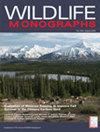{"title":"山齿鹑(Colinus)的系统地理学","authors":"Damon Williford, Randy W. Deyoung, Rodney L. Honeycutt, Leonard A. Brennan, Fidel Hernández","doi":"10.1002/wmon.1017","DOIUrl":null,"url":null,"abstract":"<div>\n \n \n <section>\n \n <p>The bobwhites (<i>Colinus</i>) consist of 3 grassland-associated, allopatric species of New World quails (family Odontophoridae): the northern bobwhite (<i>C. virginianus</i>), distributed from the eastern United States to Guatemala; the black-throated bobwhite (<i>C. nigrogularis</i>), which occurs in scattered localities in the Yucatán Peninsula, Nicaragua, and Honduras; and the crested bobwhite (<i>C. cristatus</i>), whose range stretches from Guatemala to northern Brazil. We used mitochondrial DNA (mtDNA) sequences from both the control region and the ND2 gene to study the phylogenetic relationships and phylogeography of the 3 bobwhite species. We developed ecological niche models to evaluate conclusions inferred from genetic data. <i>Colinus</i> was composed of 2 deeply divergent lineages, 1 represented by the crested bobwhite and the other by northern and black-throated bobwhites, both of which were genetically distinct from each other. Although the northern bobwhite had high haplotype diversity, this species exhibited evidence of past demographic and geographic expansion, no phylogeographic structure, and no congruence between genetic variation and subspecies taxonomy. Ecological niche modeling was congruent with a recent range expansion for the northern bobwhite from Late Pleistocene refugia in México and the southern United States. The black-throated bobwhites from the Yucatán Peninsula were distinct from those in Nicaragua, and as a whole this species displayed little evidence of recent expansion. Ecological niche modeling suggested that the current, fragmented distribution of the black-throated bobwhite has existed for the past 130,000 years. Although the crested bobwhite displayed little evidence of population expansion, the mtDNA data revealed 3–4 geographically and genetically distinct lineages. Results of niche modeling suggest that the crested bobwhite had a much wider distribution in Central and South America during the Last Glacial Maximum. Given the sensitivity of all 3 bobwhite species to climatic cycles, managers should consider impacts of climate change in addition to the loss of habitat when crafting conservation plans. © 2015 The Wildlife Society.</p>\n </section>\n </div>","PeriodicalId":235,"journal":{"name":"Wildlife Monographs","volume":"193 1","pages":"1-49"},"PeriodicalIF":4.3000,"publicationDate":"2015-12-24","publicationTypes":"Journal Article","fieldsOfStudy":null,"isOpenAccess":false,"openAccessPdf":"https://sci-hub-pdf.com/10.1002/wmon.1017","citationCount":"13","resultStr":"{\"title\":\"Phylogeography of the bobwhite (Colinus) quails\",\"authors\":\"Damon Williford, Randy W. Deyoung, Rodney L. Honeycutt, Leonard A. Brennan, Fidel Hernández\",\"doi\":\"10.1002/wmon.1017\",\"DOIUrl\":null,\"url\":null,\"abstract\":\"<div>\\n \\n \\n <section>\\n \\n <p>The bobwhites (<i>Colinus</i>) consist of 3 grassland-associated, allopatric species of New World quails (family Odontophoridae): the northern bobwhite (<i>C. virginianus</i>), distributed from the eastern United States to Guatemala; the black-throated bobwhite (<i>C. nigrogularis</i>), which occurs in scattered localities in the Yucatán Peninsula, Nicaragua, and Honduras; and the crested bobwhite (<i>C. cristatus</i>), whose range stretches from Guatemala to northern Brazil. We used mitochondrial DNA (mtDNA) sequences from both the control region and the ND2 gene to study the phylogenetic relationships and phylogeography of the 3 bobwhite species. We developed ecological niche models to evaluate conclusions inferred from genetic data. <i>Colinus</i> was composed of 2 deeply divergent lineages, 1 represented by the crested bobwhite and the other by northern and black-throated bobwhites, both of which were genetically distinct from each other. Although the northern bobwhite had high haplotype diversity, this species exhibited evidence of past demographic and geographic expansion, no phylogeographic structure, and no congruence between genetic variation and subspecies taxonomy. Ecological niche modeling was congruent with a recent range expansion for the northern bobwhite from Late Pleistocene refugia in México and the southern United States. The black-throated bobwhites from the Yucatán Peninsula were distinct from those in Nicaragua, and as a whole this species displayed little evidence of recent expansion. Ecological niche modeling suggested that the current, fragmented distribution of the black-throated bobwhite has existed for the past 130,000 years. Although the crested bobwhite displayed little evidence of population expansion, the mtDNA data revealed 3–4 geographically and genetically distinct lineages. Results of niche modeling suggest that the crested bobwhite had a much wider distribution in Central and South America during the Last Glacial Maximum. Given the sensitivity of all 3 bobwhite species to climatic cycles, managers should consider impacts of climate change in addition to the loss of habitat when crafting conservation plans. © 2015 The Wildlife Society.</p>\\n </section>\\n </div>\",\"PeriodicalId\":235,\"journal\":{\"name\":\"Wildlife Monographs\",\"volume\":\"193 1\",\"pages\":\"1-49\"},\"PeriodicalIF\":4.3000,\"publicationDate\":\"2015-12-24\",\"publicationTypes\":\"Journal Article\",\"fieldsOfStudy\":null,\"isOpenAccess\":false,\"openAccessPdf\":\"https://sci-hub-pdf.com/10.1002/wmon.1017\",\"citationCount\":\"13\",\"resultStr\":null,\"platform\":\"Semanticscholar\",\"paperid\":null,\"PeriodicalName\":\"Wildlife Monographs\",\"FirstCategoryId\":\"99\",\"ListUrlMain\":\"https://onlinelibrary.wiley.com/doi/10.1002/wmon.1017\",\"RegionNum\":1,\"RegionCategory\":\"生物学\",\"ArticlePicture\":[],\"TitleCN\":null,\"AbstractTextCN\":null,\"PMCID\":null,\"EPubDate\":\"\",\"PubModel\":\"\",\"JCR\":\"Q1\",\"JCRName\":\"ECOLOGY\",\"Score\":null,\"Total\":0}","platform":"Semanticscholar","paperid":null,"PeriodicalName":"Wildlife Monographs","FirstCategoryId":"99","ListUrlMain":"https://onlinelibrary.wiley.com/doi/10.1002/wmon.1017","RegionNum":1,"RegionCategory":"生物学","ArticlePicture":[],"TitleCN":null,"AbstractTextCN":null,"PMCID":null,"EPubDate":"","PubModel":"","JCR":"Q1","JCRName":"ECOLOGY","Score":null,"Total":0}
引用次数: 13


